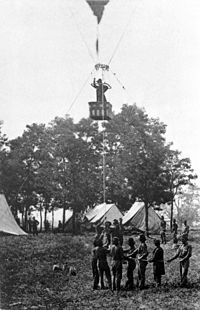Fleurbaix Toy Soldiers - American Civil War Balloon
Fleurbaix Toy Soldiers - American Civil War Balloon
 |
Fleurbaix Toy Soldiers - American Civil War Balloon |
Fleurbaix Fleurbaix Toy Soldiers - American Civil War Fleurbaix Toy Soldiers - American Civil War Balloon
 Fleurbaix Toy Soldiers - American Civil War Fleurbaix Toy Soldiers - American Civil War Balloon |
| Intrepid being cross-inflated from Constitution in a spur-of-the-moment attempt to get the larger balloon in the air to overlook the imminent Battle of Fair Oaks |
Fleurbaix Toy Soldiers - American Civil War Balloon
The Intrepid was a hydrogen gas balloon or aerostat built for use by the Union Army Balloon Corps for aerial reconnaissance purposes during the American Civil War. It was one of seven balloons constructed for the Balloon Corps and was one of the four larger balloons designed to make ascensions to higher elevations with a larger lift capacity for telegraph equipment and an operator. It was the balloon of choice for Chief Aeronaut Thaddeus Lowe overlooking the Battle of Fair Oaks.[1]
The fateful flight over the Battle of Fair Oaks was instrumental in saving the fragmented army of Union Army General Samuel P. Heintzelman from what would have been a sure defeat at the hands of the Confederates. The Intrepid undergoing lengthy inflation was quickly hooked up to the spout of the smaller Constitution by means of a de-bottomed camp kettle by which the gas was transferred in a shorter time to make the ascent. From Wikipedia, the free encyclopedia
 |
| Thaddeus Lowe ascending in the Intrepid to observe the Battle of Fair Oaks. |
Fleurbaix Toy Soldiers - American Civil War Fleurbaix Toy Soldiers - American Civil War Balloon

Gettysburg: an Alternate History (Greenhill Military Paperback)
Review
So close, so very, very close Peter G. Tsouras' Gettysburg: An Alternate History, is a fun read for those who are more than a little familiar with that monumental battle. He sets the table well with historical pre-battle events. The First day is pretty much as it was and things do not start to change dramatically until the bloody 2nd day of battle. It is interesting how Mr Tsouras gets Robert E. Lee to change his original battle plan and adopt General James Longstreet's tactical plan. Allowing Longstreet to use his plan of attack on the 2nd day changes General Longstreet's enthusiasm for battle. He takes aggressively takes charge and the battle is joined on General Meade's left flank and rear. Still, the fog of war allows the Union to whether the storm although left in a precarious state. Day 3 would tell the tale in Mr Tsouras' alternate battle of Gettysburg. Day 3 dawned clear and hot with Robert E. Lee in relatively good shape compared to General Meade's somewhat precarious position. Still, the outcome was in somewhat of doubt as General Lee decides to attack the middle of the Union line. Massing over 35,000 Confederate troops to be led by General James Longstreet after a thunderous cannonade, It certainly appeared to everyone that General Lee had the upper hand. The final battle was joined with General Longstreet leading his gallant troops in the field: 35,000 strong. Mr Tsouras' outcome is indeed an alternate history worth reading. I liked this book. I enjoyed Mr Tsouras' use of maps, interesting dialogue, and alternate possibilities. The Culp's Hill and Cemetery Hill day 2 action was very interesting. I also enjoyed how he kept pretty close to actual history concerning the 1st day's events. All in all a fun read for civil war buffs. Beware for the uninitiated for this is an alternate history with days 2 and 3 radically different from what really happened at Gettysburg. Could this have actually happened as Mr Tsouras portrays? That's the fun of What IF scenarios; anything is possible in an alternate universe! Robert C. Olson review by

Comments
Post a Comment